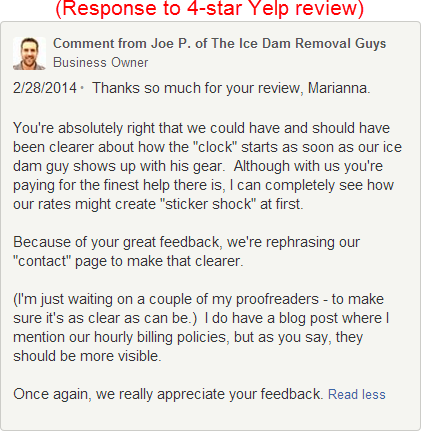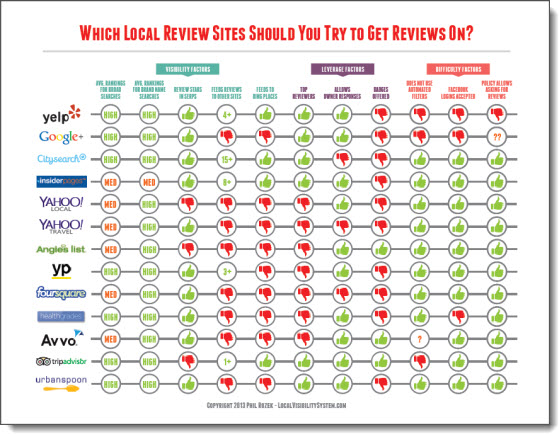
Step 1. Commit – or don’t.
What do you want? What disaster are you trying to keep away from your reputation?
You’ll need to be patient and have a little fire in your belly – no matter what you’re trying to accomplish or avoid.
And you’ll need to learn from your reviews to make your business better. Or else your reputation will own you, and not the other way around.
Step 2. Get listed on the big review sites and on at least a few industry-specific sites.
Remove duplicate and incorrect listings along the way.
These sites are the only places you can get online reviews – at least the kind that can really help your local visibility and rankings. If you don’t have listings on these sites, nothing else matters and you will get zero reviews. Testimonials – AKA bits of “fan mail” that you post on your site – don’t count.
Step 3. Respond to any negative reviews you find. (Read this and this.)
Mend bridges with those customers. Work on the underlying issue(s) they complained about, if humanly possible.
Step 4. Make it easy to leave spontaneous reviews.
Link to a couple of your listings in your email signature.
Put a gentle nudge on your invoices or receipts.
Link to some of your listings from your site – preferably with noticeable “buttons.”

You can make these yourself, or you can use tools like ReviewBiz or Grade.us.
Step 5. Start asking all your new customers – and preferably old and existing customers – for their email addresses.
Find a way to make it worth their while. This will be important for later.
Step 6. Pick about 5 customers and ask them to review you somewhere.
It could be on Google+, or on an easier site that accepts Facebook usernames. Whatever you do, don’t push them toward Yelp; you need a different strategy there.
Try to ask them in-person and to provide simple printed instructions, if possible (example).
Step 7. Check back a week or two later to see who posted a review, and follow up.
Thank any customers who did. Reconnect with the ones who didn’t. Ask if there’s any way you can help them in general, and mention again that you’d really appreciate a review.
Step 8. Set up whatever system you want to use for contacting customers by email
Consider using a tool like GetFiveStars. It makes it easy to follow up with customers by email (remember step #5?), and it lets you track your reviews.
Or you can use an email service like Aweber or MailChimp.
Email a handful of your customers to ask if they’ll review you. These can be people you already asked in-person and are just reminding, or they can be another batch of customers you’re asking for the first time.
Don’t ask all your customers at once: You don’t want to wear out your welcome while you’re just trying to figure out what timing and language seems to work best, and how email should fit in.
Step 9. Apply whatever you learned from the previous batch of reviewers. Not only in terms of how to make your requests easier to say “yes” to, but also in terms of what they might have said in their reviews. What were their gripes, and what can you do about them?

(By the way, if it seems like you’ve done this step before, you’re right. And you’ll do it again and again. If you don’t learn from your reviews, they’re just dots on the screen.)
Step 10. Respond to any reviews you can. Tell the less-happy people what you’ve done to improve (see Step 9). Say thanks to the happier customers, where appropriate.
Step 11. Continue asking small groups of customers – like 2-10 – every week for reviews.
It doesn’t need to be the exact-same number every week. But don’t ask zero customers one month and then 40 the next month. Be somewhat consistent.
Ask everyone twice: ideally you ask in-person first, and then by email. Don’t be a pest. Just give a friendly reminder. Space these out by 5-10 days.
Step 12. Experiment. Try something different every few “batches.”
Ask customers to go to different sites – not the same one each time. (Make new instructions for new sites if needed.) Try sending printed follow-ups by snail-mail. If you usually ask customers on Tuesdays and Thursdays, try asking on a Friday. Mix it up. See what seems to work.
Step 13. Keep repeating steps 9-12 to infinity. Tweak your processes as much as you feel you need to, but never stop asking, refining, and acting.
Enjoy the great reviews and happy customers.
—
What steps have you done in your review strategy so far?
How do they compare to the one I suggest?
Any questions or advice for me? Leave a comment!

Great post here Phil! I’ll not send ANY clients here tho to read same….gotta keep some stuff “only” for us SEO Practitioners, eh!
Kudos lad…this is pretty much ‘best practices’ material!!!
🙂
Hey, thanks a bunch, Jim!
Once again, some excellent info on how businesses can put together a strategy. This strategy is general, therefore, any business could try it out. I like that you mention MailChimp and AWeber. We have set clients up with MailChimp and Wysija (now called mailpoet) a WordPress Plugin which are easy to setup and monitor. I do need to take a look at GetFiveStars since all of you are mentioning it. If it makes it easy on the client, than I’m all for recommending.
Great job here – thanks!
I’ve heard Mailpoet is good.
Thanks, Susan!
Another great post on Reviews here Phil. Step 3 is an interesting one. It’s tricky enough to hammer home the importance of reaching out to clients to leave reviews. Training SMB’s in the art of the review response is equally tricky and twice as interesting.
I would take it another step and say that all reviews should be responded to, not just the bad ones. I would love to see Google enable a feature that sends the review response to the reviewers e-mail!
Thanks, Colan.
I totally agree about not just responding to the negative reviews; see step 10 🙂 The initial responses I mentioned in step 3 are just damage-control, if there are some highly visible dud reviews.
Good stuff man. Thanks for postin!
Sure thing, Tyson!
Thanks Phil,
This also gives me a yet another good approach to those who are reluctant to go for reviews.
You’re welcome, Holly!
I like to make walk-though videos explaining how to sign up on various services and leave reviews. So far they’ve been specific to business but I may make some generic ones if anyone cares to use them.
That’s a good approach, Gene. I used to make those (for Google reviews). They’re a pain to update, though.
Thanks for the offer on generic videos. Yeah, please let me know and maybe I can post them.
Great article!
Anyone know of any good tools that allow you to monitor your reviews across the web? Local Report Tools is the one I use.
Thanks, Rachel.
1. The “new” Google Places dashboard has an area where you can monitor your reviews on a bunch of sites – the only big exception being Yelp.
2. GetFiveStars.com – which I’ve written about pretty extensively.
3. Trackur.com.